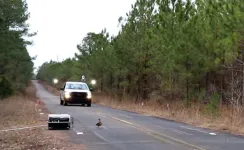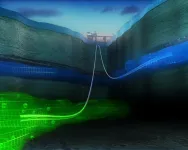(Press-News.org) Professor Ron Boschma is the first Dutch person to receive the Prix Vautrin Lud, the highest academic award within the field of geography. The award will be presented in Saint-Dié-des-Vosges, France on 6 October. Prior to the award ceremony, Prof. Boschma will give an invited lecture at the Sorbonne University in Paris on 4 October. Boschma was nominated for the award in recognition of his scientific contributions to the field of economic geography, especially for laying the foundations of evolutionary economic geography and his research into regional diversification and innovation policy. The European Union’s regional policy is based in part on his research.
The award was created in 1991, and is presented every year at the Festival International de Géographie in Saint-Dié-des-Vosges, France. The festival organisers created the award due to the lack of a Nobel Prize for Geography. Nominations for the Prix Vautrin Lud go through the same procedure as the Nobel Prize: around 500 experts from around the world can submit nominations, and an international committee chooses the winner.
Calculating plans
Regional governments each have their own priorities, but not all of them find a realistic way to achieve their goals. Boschma is able to calculate whether the choices made by European regions are feasible or not. “For example, the Netherlands wants to play a leading role in the field of cybersecurity, but it’s not clear that we have the necessary competencies to do that”, cautions the researcher. “On the other hand, we’ve seen that the north of the country has wisely chosen to develop hydrogen, and that the province of North Brabant has had success in developing imaging technologies.”
Industrial policy
The importance of regional policy in the European Union is reflected by the fact that it spends almost 100 billion euros on the regions on a yearly basis. “You could see it as the EU’s biggest policy intervention, with the goal of reducing income disparities between countries and regions. Regional policy should pursue an active industrial policy that sets the right priorities. Industrial policy used to be a dirty word, but now governments actively promote the development of certain sectors.”
ASML
Boschma does have some words of caution, however. “The Netherlands is generally a very ‘centralistic’ country. The national government really has no idea what’s going on at the regional level. It took a very long time before national policymakers realised that our country had a ‘brainport’ in the region around Eindhoven, alongside the two ‘mainports’ Amsterdam and Rotterdam. Photolithography machines manufacturer ASML is a major international player there. But if we don’t watch out, the company will start to play an overly dominant role, and will draw all of the dynamism from other activities in the region. That will require some carefully thought-out policy.”
Economics
Ron Boschma studied Human Geography at the University of Amsterdam, and earned his PhD at Erasmus University Rotterdam’s Tinbergen Institute in 1994. His appointment as a Professor at Utrecht University’s Faculty of Geosciences followed 10 years later. Before that, he served as Professor of Innovation Studies at Lund University in Sweden, which made him eligible to submit nominations for the Nobel Prize in Economics.
Capital of Geography
The idea for the award was born in 1990, during the first edition of the Festival International de Géographie, a three-day event for scientists and the interested public. The programme includes symposia and academic presentations by geographers, but also films and exhibitions. The festival has put Saint-Dié-des-Vosges on the map as the ‘international capital of geography’. The award was named after Vautrin Lud, who was born in the city in the east of France. It was under his auspices that the first map was published bearing the name ‘America’ in 1507. For more information about the festival, see: https://fig.saint-die-des-vosges.fr/
END
High academic award for economic geographer Ron Boschma
2024-09-25
ELSE PRESS RELEASES FROM THIS DATE:
Study reveals mallards' flight responses ineffective in preventing vehicle collisions
2024-09-25
Research Highlights Risk to Both Humans and Wildlife, Suggests Need for New Collision Mitigation Strategies
A recent article published in PeerJ Life & Environment has uncovered insights into how mallards (Anas platyrhynchos) respond to approaching vehicles, revealing that these common waterbirds are poorly equipped to avoid collisions, particularly at high speeds. The research, which used both simulated and real-world vehicle approaches, highlights the urgent need for improved methods to reduce bird-vehicle collisions—events that are not only financially costly but also dangerous to both humans and wildlife.
The study focused ...
Home- vs office-based narrowband UV-B phototherapy for patients with psoriasis
2024-09-25
About The Study: In this randomized clinical trial, home-based phototherapy was as effective as office-based phototherapy for plaque or guttate psoriasis in everyday clinical practice and had less burden to patients.
Corresponding Author: To contact the corresponding author, Joel M. Gelfand, MD, email joel.gelfand@pennmedicine.upenn.edu.
To access the embargoed study: Visit our For The Media website at this link https://media.jamanetwork.com/
(doi:10.1001/jamadermatol.2024.3897)
Editor’s Note: Please see the article for additional information, including other authors, ...
Major boost in carbon capture and storage essential to reach 2°C climate target
2024-09-25
Large expansion of carbon capture and storage is necessary to fulfill the Paris Climate Agreement. Yet a new study led by Chalmers University of Technology, in Sweden and University of Bergen, in Norway, shows that without major efforts, the technology will not expand fast enough to meet the 2°C target and even with major efforts it is unlikely to expand fast enough for the 1.5°C target.
The idea behind carbon capture and storage (CCS) technology is to capture carbon dioxide then store it deep underground. Some applications of CCS, such ...
‘Invisible forest’ of algae thrives as ocean warms
2024-09-25
An “invisible forest” of phytoplankton is thriving in part of our warming ocean, new research shows.
Phytoplankton are tiny drifting organisms that do about half of the planet’s “primary production” (forming living cells by photosynthesis).
The new study, by the University of Exeter, examined phytoplankton at the ocean surface and the “subsurface” – a distinct layer of water beneath – to see how climate variability is affecting them.
Published in the journal Nature Climate Change, the findings show these two communities are reacting differently.
Over the last decade, the total “biomass” (living material) of subsurface ...
How do rare genetic variants affect health? AI provides more accurate predictions
2024-09-25
Whether we are predisposed to particular diseases depends to a large extent on the countless variants in our genome. However, particularly in the case of genetic variants that only rarely occur in the population, the influence on the presentation of certain pathological traits has so far been difficult to determine. Researchers from the German Cancer Research Center (DKFZ), the European Molecular Biology Laboratory (EMBL) and the Technical University of Munich have introduced an algorithm based on deep learning that can predict the effects of rare genetic variants. The method allows persons with high risk of disease to be distinguished more precisely and facilitates the identification ...
Replacing hype about artificial intelligence with accurate measurements of success
2024-09-25
The hype surrounding machine learning, a form of artificial intelligence, can make it seem like it is only a matter of time before such techniques are used to solve all scientific problems. While impressive claims are often made, those claims do not always hold up under scrutiny. Machine learning may be useful for solving some problems but falls short for others.
In a new paper in Nature Machine Intelligence, researchers at the U.S. Department of Energy’s Princeton Plasma Physics Laboratory (PPPL) and Princeton University performed a systematic review of research comparing machine learning to traditional methods for solving ...
Researchers harness AI to repurpose existing drugs for treatment of rare diseases
2024-09-25
There are more than 7,000 rare and undiagnosed diseases globally.
Although each condition occurs in a small number of individuals, collectively these diseases exert a staggering human and economic toll because they affect some 300 million people worldwide.
Yet, with a mere 5 to 7 percent of these conditions having an FDA-approved drug, they remain largely untreated or undertreated.
Developing new medicines represents a daunting challenge, but a new artificial intelligence tool can propel the discovery of new therapies from existing medicines, offering hope for patients with rare and neglected conditions and for the clinicians who treat them.
The AI model, called TxGNN, is the first one ...
Combination treatment improves response to immunotherapy for lung cancer
2024-09-25
Francis Crick Institute press release
Under strict embargo: 10:00hrs BST Wednesday 25 September 2024
Peer reviewed
Experimental study
Animals
Combination treatment improves response to immunotherapy for lung cancer
Researchers at the Francis Crick Institute, in collaboration with Revolution Medicines, have tested a combination of treatments in mice with lung cancer and shown that these allow immunotherapies to target non-responsive tumours.
Their findings show that targeting tumours in ...
Nanostructures in the deep ocean floor hint at life’s origin
2024-09-25
Researchers led by Ryuhei Nakamura at the RIKEN Center for Sustainable Resource Science (CSRS) in Japan and The Earth-Life Science Institute (ELSI) of Tokyo Institute of Technology have discovered inorganic nanostructures surrounding deep-ocean hydrothermal vents that are strikingly similar to molecules that make life as we know it possible. These nanostructures are self-organized and act as selective ion channels, which create energy that can be harnessed in the form of electricity. Published Sep. 25 in Nature Communications, the findings impact not only our understanding of how life began, but can also ...
Humbug damselfish use 'motion dazzle' to evade predators
2024-09-25
When thinking of animal camouflage, we typically imagine creatures remaining still, blending seamlessly into their surroundings. But remaining motionless isn’t always practical, and many animals are highly mobile, constantly moving through their environment to graze their food.
New research suggests that high-contrast patterns on animals’ bodies may serve a dual purpose: offering camouflage when stationary, then creating a ‘motion dazzle’ effect when moving, confusing potential predators into misjudging their location – and helping them avoid being ...





